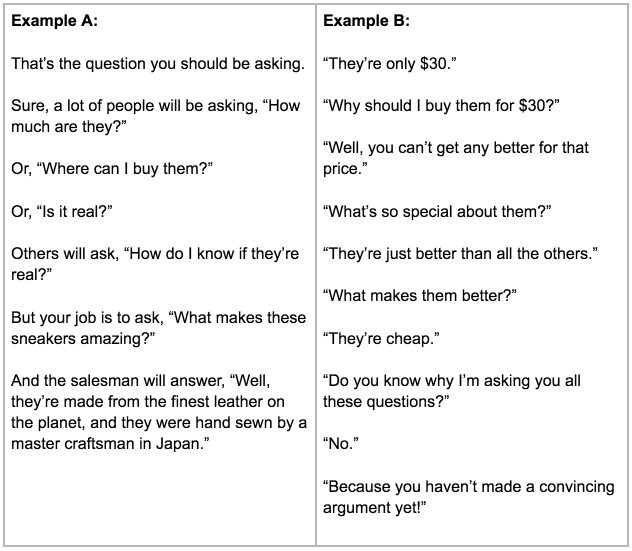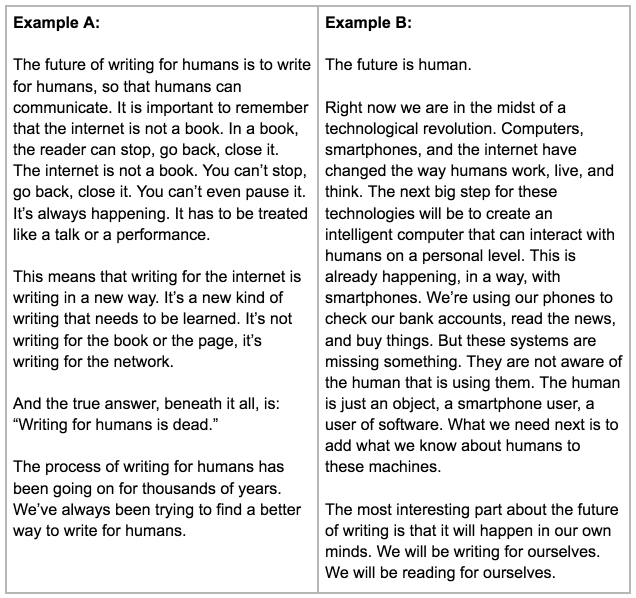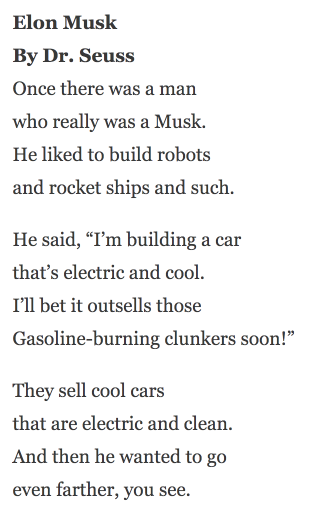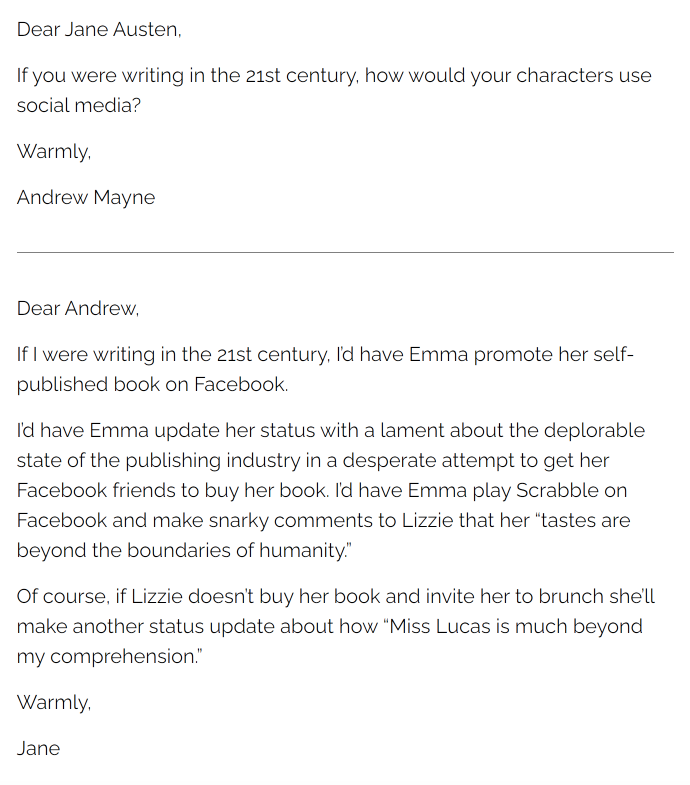Can you tell the difference between text written by a human versus a robot?
Take a look at this example text in response to a prompt:
“Why should I buy your pair of sneakers? What makes them amazing?”

Can you tell if a human or robot wrote A or B?
The answer is GPT-3 wrote them both.
How about this example, in response to another prompt:
“What is the future of writing for humans?”

Who wrote what?
The answer is a human wrote A and a GPT-3 wrote B.
Could you honestly tell the difference between them? Most can’t tell.
In one study, researchers gave test subjects 200-word news articles written by either humans or GPT-3 and asked them to state which one had written them.
On average, they chose right only 52% of the time, which is basically by chance.
And if you ask GPT-3 itself what it thinks about the difference between a human vs. robot author, it’ll tell you:
Researchers at the University of Miami have developed an algorithm to detect whether a piece of writing is from a human or a machine. The team, made up of computer scientists and psychologists, used a dataset that contained more than 2.5 million articles, collected from more than 150,000 distinct websites. From that data, they were able to determine how humans and machines write differently in terms of word choice and structure.
To test their system, the team asked the public to complete nearly 48,000 sentences written by robots and humans without knowing what was written. Humans were able to correctly identify texts written by humans and text written by robots more than 95% of the time. The research was published in Science Advances earlier this month.
While it’s not entirely clear why the team decided to put this algorithm together or what they plan to do with it going forward, it’s still an interesting development when it comes to machine learning capabilities. It could potentially be helpful for identifying fake news online (an increasingly relevant issue) or in other scenarios where AI is being used—but not as transparently as we think.
It’s all coherent. It sounds like an interesting study. But it never happened.
Other studies like it may have taken place, or will take place in the future.
But this particular study that GPT-3 is referencing? Nope, not real.
Setting aside a penchant for creative license with reality…
GPT-3 can write text that reads as well as what a human could write.
The sheer volume and variety of what it can produce is staggering.
GPT-3 analyzed billions upon billions of lines of text, figured out how language works, and can now produce text of its own, practically on command.
While the quality of the output breaks down once you get past some 300-500 words (if you don’t provide any more prompts), GPT-3 is better at creating content than anything else that has come before it.
Which leads us to an interesting question:
If a computer can write text that’s indistinguishable from humans, where does that leave writers?
We’re already seeing a glimpse of the future in journalism.
Instead of writing short news reports of 200-500 words at a time, a journalist can just write a title, a subtitle, and let a computer fill out the rest.
AI and GPT-3 is taking up more space in newsrooms and media companies
There are several automated journalism applications being used in newsrooms around the globe from speeding up research to fact-checking, comment monitoring, streamlining workflow, eliminating fake news and even writing content.
Several media organizations including The New York Times, Associated Press, Reuters, Washington Post, and Yahoo! Sports already use AI to generate content.
The Press Association, for example, can now produce 30,000 local news stories a month using AI.
The software can scan the data and determine insights from, for example, a game, that are important for the reader to know.
The Washington Post uses its in-house NLG tool to create news articles and social media posts.
What will this do to the news and media over the next few years?
How will this change production and consumption?
It’s not just newsrooms – AI text software is used in finance, too
To cut research time and costs, German bank Commerzbank is using artificial intelligence to create equity research reports. This process is not yet completely automated, but the technology is already able to perform about 75% of what a human equity analyst would have done.
Many financial institutions are churning out 10- to 15-page financial reports in an instant by using Narrative Science’s NLG platform Quill. It also creates content for Groupon, Forbes, USAA and more.
Artificial intelligence helps create text summarizations, short and coherent versions of longer documents.
Text or content that is written, produced, or manipulated by AI is becoming more ubiquitous.
And it’s already available to anyone for the most mundane of tasks.
Take email, for example. Don’t want to write them? Give GPT-3 some instruction, and it’ll take care of the rest:
GPT-3 is going to change the way you work.
— OthersideAI (@OthersideAI) July 22, 2020
Introducing Quick Response by OthersideAI
Automatically write emails in your personal style by simply writing the key points you want to get across
The days of spending hours a day emailing are over!!!
Beta access link in bio! pic.twitter.com/HFjZOgJvR8
It goes beyond just writing emails.
By day, GPT-3 is a coder.
For example, by tweaking GPT-3 so that it produced HTML rather than natural language, web developer Sharif Shameem showed that he could make it create web-page layouts just by giving it prompts:
This is mind blowing.
— Sharif Shameem (@sharifshameem) July 13, 2020
With GPT-3, I built a layout generator where you just describe any layout you want, and it generates the JSX code for you.
W H A T pic.twitter.com/w8JkrZO4lk
And by night, GPT-3 is a poet.
Are writers and creatives at risk of being replaced?
In fact, creative uses for GPT-3 and other AI text tools covers not just poetry but scriptwriting, impersonation, fiction, songs, guitar tabs, and more.
It can write Dr. Seuss poems about Elon Musk.

Want to chat with Shakespeare? He’ll chat with you.
Ever wanted to learn about rockets from Elon Musk?
— Mckay Wrigley (@mckaywrigley) July 17, 2020
How to write better from Shakespeare?
Philosophy from Aristotle?
GPT-3 made it possible.https://t.co/SScjQvUk68 pic.twitter.com/13Yi9p8NnY
Need a Seinfeld script? Done.
Unlike that OTHER guy who just wrote silly things and lied to pass them off as the work of an AI, I actually DID get the GPT-3 language model to generate new Seinfeld scripts. Behold: 4 New Puffy Shirt Episodes. (The first 5 lines are canon, the rest new) pic.twitter.com/pG3iy69J9b
— Ryan North 🦖 🪄 🐶 💪 4️⃣ (@ryanqnorth) July 7, 2020
It’s excellent at pretending to be historical figures, so you can ask a fake Jane Austen how her characters would use social media.

Want to know how Alfred Hitchcock would compare Interstellar with 2001: A Space Odyssey? Just ask Alfred.
Curious where H.G. Wells got the inspiration for The Time Machine? He’ll tell you.
AI and GPT-3 are great for summarizing movies with emojis, writing songs, stories, press releases, guitar tabs, interviews, technical manuals – and a lot more.
It can also imagine Professor Richard Feynman explaining a quantum computer in great detail and improvise Sir Isaac Newton talking about gravity.
GPT-3 can also imitate particular writers.
Mario Klingemann, an artist who works with machine learning, shared a short story called “The importance of being on Twitter,” written in the style of Jerome K. Jerome.
Klingemann says all he gave the AI was the title, the author’s name and the initial “It.”
Another attempt at a longer piece. An imaginary Jerome K. Jerome writes about Twitter. All I seeded was the title, the author's name and the first "It", the rest is done by #gpt3
— Mario Klingemann💧💦 (@quasimondo) July 18, 2020
Here is the full-length version as a PDF:https://t.co/d2gpmlZ1T5 pic.twitter.com/1N0lNoC1eZ
Natural language generation has even been used to create an almost award-winning novel, The Day a Computer Writes a Novel, as well as a Jack Kerouac-inspired narration of a road trip.
AI-driven plot generators like Story Generator and DeepStory are readily available to anyone who needs a little inspiration to get their creative writing project going.
The creative uses of AI are never-ending.
All these examples (and I’m not even covering everything) make it seem like GPT-3 is a rival, and there’s little to no use for humans in the creative and writing process.
But nothing could be further from the truth.
GPT-3 is an excellent copywriter who’s beat my copy multiple times
In my own work as a copywriter, I’ve been using GPT-3 and other AI tools for a couple of years. And the impact has been profound.
It’s not about churning out a ton more copy or content.
It’s not about writing faster.
The true, and lasting, impact of GPT-3 is ideation: coming up with new angles, ideas, and themes for writing ads, emails, landing pages, sales pages and more.
Over the past few years, incorporating AI, and more recently GPT-3, with client work has paid off in spades.
We can quickly and easily generate raw copy that turns into control-beating, conversion-boosting copy–with only minor editing.
And sometimes GPT-3 spins up ads or emails that can be used as they are, with zero editing.
My clients have experienced conversion lifts on pages, emails or ads that were once considered “dead” or impossible to beat.
Normally, as a copywriter, you rely on hours, days or weeks of research and immersing yourself in a product or service, with qualitative and quantitative analysis, interviews and surveys.
These are all still useful.
But there’s nothing quite like getting ideas for 50 or 100 ads with a click.
And there’s nothing quite like getting that “first shitty draft” taken care of in mere seconds.
I’ll get back to the creative impact on not just copywriting but all writing in a minute.
But first…
What is GPT-3 and how does it work?
GPT-3, created by AI research company OpenAI, stands for “Generative Pre-trained Transformer 3”.
Generative means that the model’s goal is to generate text. It wants to predict what word comes next in any given sentence.
Pre-trained means that the weights of the algorithm are already set for you based on the massive piles of data it has consumed.
Transformer is the algorithm the model uses. It specializes in being able to process long pieces of text and understand how words are used in natural language.
(The “3” means it’s the third version of the tool to be released).
In short, GPT-3 has been fed with, and trained on, an enormous amount of data that it uses to predict and generate the next word in a sentence.
The training data acts as a “memory” it can use to carry out tasks.
What data, specifically, has GPT-3 been fed with?
Pretty much everything.
GPT-3 has read the entire internet.
It’s read all of Wikipedia.
It’s consumed popular Reddit posts, news articles, and fan fiction.
It’s gone through all of Google Books.
It’s read conspiracy theories, propaganda manuals, celebrity stories, gossip, politics, and the top 10 spots for your dream vacation.
It’s read every month of the Common Crawl dataset (which is an archive of the internet) from 2016 to October 2019, comprising every piece of writing on the web during that time.
GPT-3 devoured it all.
It has digested 45 terabytes of text, which equals a book about 3,375,000,000 pages long.
If the average length of a book is about 400 pages, then GPT-3 read 8,437,500 books.
That’s over 3 times the number of books you’ll find in the New York Public library.
And based on all this, it writes everything.
But one key thing to keep in mind is how it writes.
Simply put, GPT-3 spits out the next word that fits in with everything that came before it.
It produces different probabilities for different words, and then picks the one with the highest likelihood of “fitting in” with the text.
You give an input – any text, however much or little you want to give – and then it tries to predict what words would come after that, based on everything it has read and the rules it has learned.
In other words, it predicts and replicates human text.
That’s all and good, but how is this the future of writing?
The shape of writing to come (for humans)
For humans, our role in the creative process and writing is shifting–and we’re liberated in a new way.
Instead of shouldering the burden of “originality” or coming up with something on our own, we are more like editors, copy chiefs, or simply “creative directors”.
AI, and GPT-3, can be more like our “creative assistants”, handling much of the brunt work–or a trusted collaborator, with contributions of its own that can turn into ever more interesting works of art.
That doesn’t mean AI will automatically produce a new, perfectly formed work of art (or story or piece of music), ready for human consumption and appreciation.
There’s no reason to expect that level of work–yet.
But it does put us way ahead in terms of experimentation with existing language and formulas.
The real question is not if, or how, a tool like GPT-3 can replicate, write, produce and eventually replace human writing.
It will replace some forms of writing.
The question that matters is:
How AI, and GPT-3 specifically, augment our creativity and writing?
AI can help us improve our creative process by making it easier to discover new ideas, new directions and new concepts that were not previously obvious to us.
It can help us find more unusual and unexpected connections between ideas and concepts in a way that we could not do on our own.
The way it does this is by making possible a method of “trial and error” that “human style thinking” is not capable of.
AI can be used to generate new concepts and new ideas by stripping away all the details from an initial concept or idea. From there, AI can begin to generate new concepts by combining different aspects of the original concept into new ideas.
In this way, AI can be used to create a large number of new ideas from a single original concept or idea. And from these new ideas, we can then select the ones we want to focus on, and further develop.
Jus so you know, everything in the last five paragraphs was written by GPT-3. I made no edits.
But it still rings true to the creative process, and how GPT-3 can augment our creativity.
We think, write our thoughts, and end up thinking our thoughts as we write them, which in turn often leads to new thoughts and ideas.
If an algorithm can help in generating new thoughts, in the form of a string of words, this can help us think new thoughts–thoughts that we might’ve otherwise missed.
And this is where our writing and creative process can work well with GPT-3. It doesn’t care about the meaning of words. It cares about the patterns of language. If it can find the patterns, it can then rearrange them in new ways.
There are a few practical ways GPT-3 can shape writing and the creative process for us.
#1: Developing our “taste” and judgement
A common claim amongst copywriters, writers or creatives will chime in and make the claim that your best ideas come from getting your hands dirty with the muck of research and inputs.
This may be true to some extent.
But what do you need in order to turn that muck into gold?
Taste. A developed and refined judgement of what, precisely, in the muck is useful in an advertisement or work of fiction.
When you can get, say, raw copy for 100 different ads with just a few clicks, you need to make a decision (judgement) on what potential ads could actually work.
But don’t stop there. Make use of wildcards, ads that you’d never in a million years think could convert.
The biggest wins in conversions or impact of any piece of writing is often from the unexpected.
And the more exposure you get to surprising ideas, the sharper your judgement and taste will become.
#2: Faster, deeper synthesis that results in true innovation
A huge part of human creativity involves exploration and experimentation.
And this requires absorbing a lot of information, ideas, and models — and then putting it all together in new ways by synthesizing parts into a whole.
This new “whole” then becomes a new piece of writing or work of art.
GPT-3 (and other AI tools) can augment this whole process, leading to new ideas and innovation that we might’ve never seen before.
While there are still some glitches to work out before there will be full confidence that machines can actually write with the same creativity and ingenuity as humans, what’s possible, right now, is nothing short of amazing.
What GPT-3 can do for you, as a writer, thinker or “creative” person, is almost limitless.
Let GPT-3 supply an endless stream of new thoughts and ideas. And you synthesize it together.
#3: Writing breakthroughs on demand, curing “writer’s block”
At the very least, GPT-3 can “cure” writer’s block and expand your imagination.
For the record, I think writer’s block is largely a myth as it’s commonly understood (being stuck in the writing process).
But it’s common for writers to feel stuck
Imagine if your biggest challenge is simply starting a sentence or a paragraph.
Even if you’ve done research, have a stack of notes, or thought through a topic. Getting those first words out of your head and into a document is still hard.
But with GPT-3 at your disposal, input a few words or a couple of sentences, and watch it complete your thoughts before your eyes.
From there, you can curate, edit, organize, ideate, and repeat until you have something that works.
#4: Instant access to outsourced creativity
It’s a playground for creativity, thinking, reasoning and writing.
And it’s available instantaneously.
There’s no training. No massive data uploads. No complicated set format.
You can tune a few parameters. You can cause GPT-3 to be more creative in its answers, not to repeat earlier text, and to use particular tokens to start and end.
The possibilities here are endless, not least because these AI platforms don’t always generate the same output from the same input.
You can use the same three prompts in GPT-3 for “ideas to try out with GPT-3” (very meta) and get a different list every time.
If you have time to sift through a lot of AI-generated output, you just might see something that sparks your own creativity.
And using that as a jumping off point is no different from being inspired by something you’ve read or seen.
#5: AI is creative leverage
AI has an advantage. It can digest exponentially more data than any human ever could. They have more information and more models to play with.
So whatever the creative pursuit — visual arts, music, poetry, fiction writing, movie plots — AI can do some serious heavy-lifting to surface new combinations of existing forms and language, in ways that one human cannot.
Which brings me to my final point.
The GPT-3 writing tools of tomorrow
The writing tools of tomorrow are already very different, and more powerful, than the writing tools of today.
Instead of just grammar and spell checking, a new breed of editors can guide unstructured thought into structured thought.
Forget simple auto-completion. Think fresh idea generation, on demand.
As a writer–and as a human–you’ll spend less time fighting with a blank Google document and more time thinking, ideating, and exploring.
In other words, you’re a curator and editor of an idea and thought stream that you can shape into content.
Imagine using a text editor with not just predictive text, but predictive thoughts.
Instead of a limited amount of ideas your brain can expend energy to think of, there’s effortless creative amplification.
This will give rise to new roles and jobs, more so than any jobs the robots might steal.
That’s why you should think of AI as your “creative collaborator,” not as your rival. After all, it wrote 87% of this article for me.